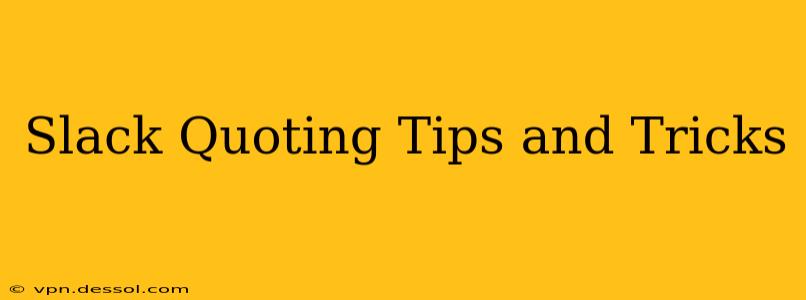Slack is a powerful communication tool, but mastering its nuances can significantly improve team collaboration and productivity. One often-overlooked yet crucial aspect is effective quoting. Knowing how to quote messages correctly can streamline conversations, reduce misunderstandings, and keep projects moving smoothly. This guide delves into various Slack quoting tips and tricks to help you become a quoting pro.
Why is Effective Quoting Important in Slack?
Before diving into the specifics, let's understand the value of proper quoting. In busy channels with numerous conversations, quoting specific messages prevents confusion and ensures everyone's on the same page. It provides context, clarifies responses, and keeps threads organized. Without effective quoting, conversations can become fragmented, difficult to follow, and prone to misinterpretations.
How to Quote a Message in Slack: The Basics
Quoting a message in Slack is straightforward. Simply hover your cursor over the message you want to quote, and you'll see a quote icon (typically an arrow pointing to the left) appear. Click it, and the message will be prepended to your reply box, ready for you to add your comment.
What are the Different Ways to Quote in Slack?
Slack offers a few variations on quoting, each serving a slightly different purpose:
-
Inline Quoting: This is the standard method described above. Ideal for short replies and quick clarifications, it keeps the conversation concise and focused.
-
Block Quoting (Multiple Messages): You can quote multiple consecutive messages by selecting them and clicking the quote icon. This is extremely useful when referencing a longer discussion thread or multiple related points.
-
Replying Directly to a Message: Slack also allows you to reply directly to a specific message, creating a threaded conversation. This method is particularly useful for keeping organized discussions within a larger channel.
Common Slack Quoting Mistakes to Avoid
While quoting is a simple concept, some common mistakes can hinder its effectiveness:
-
Quoting Entire Threads: Avoid quoting excessively long threads. This clutters the channel and makes it difficult for others to follow the conversation. Instead, focus on quoting only the relevant portions.
-
Failing to Add Context: Simply quoting a message without adding your own explanation or comment can lead to confusion. Always provide context and clearly state your response.
-
Over-Quoting: While quoting is essential, overusing it can overwhelm the channel. Be mindful of the length of your quotes and the frequency with which you quote.
H2: How Can I Use Quoting to Improve Team Collaboration?
Effective quoting directly improves team collaboration by:
- Reducing ambiguity: Quoting clarifies which message you are responding to, reducing misinterpretations and misunderstandings.
- Streamlining communication: By focusing on specific parts of a conversation, quoting helps maintain efficient and focused communication.
- Improving context: Quoting provides the necessary background for your response, allowing others to understand the conversation's flow more easily.
H2: How Can I Use Quoting to Keep Projects Moving Smoothly?
For project management within Slack, quoting is key to:
- Assigning tasks: Quote a task description and then assign it to a team member directly within the quote reply.
- Tracking progress: Quote updates and progress reports to maintain an easily accessible record.
- Resolving issues: Quote problem descriptions to ensure everyone understands the issue and can contribute to the solution.
H2: What are Some Advanced Slack Quoting Techniques?
While basic quoting is essential, here are some advanced techniques to truly master Slack quoting:
- Using formatting within quotes: You can use Slack's formatting options (bold, italics, code blocks) within your quotes to highlight key information.
- Using emoji reactions in quotes: Adding emoji reactions to quotes can express quick feedback or agreement without adding extra text.
- Combining quotes with other features: Combine quoting with other Slack features such as threads and mentions for even more efficient communication.
Conclusion: Mastering the Art of the Slack Quote
Mastering Slack quoting is more than just a technical skill; it’s a key to effective communication and collaboration. By understanding the nuances of quoting and applying these tips and tricks, you can significantly enhance your Slack experience, improve team dynamics, and boost overall productivity. Remember to quote responsibly, adding context and avoiding excessive quoting to ensure clear and efficient communication within your workspace.

